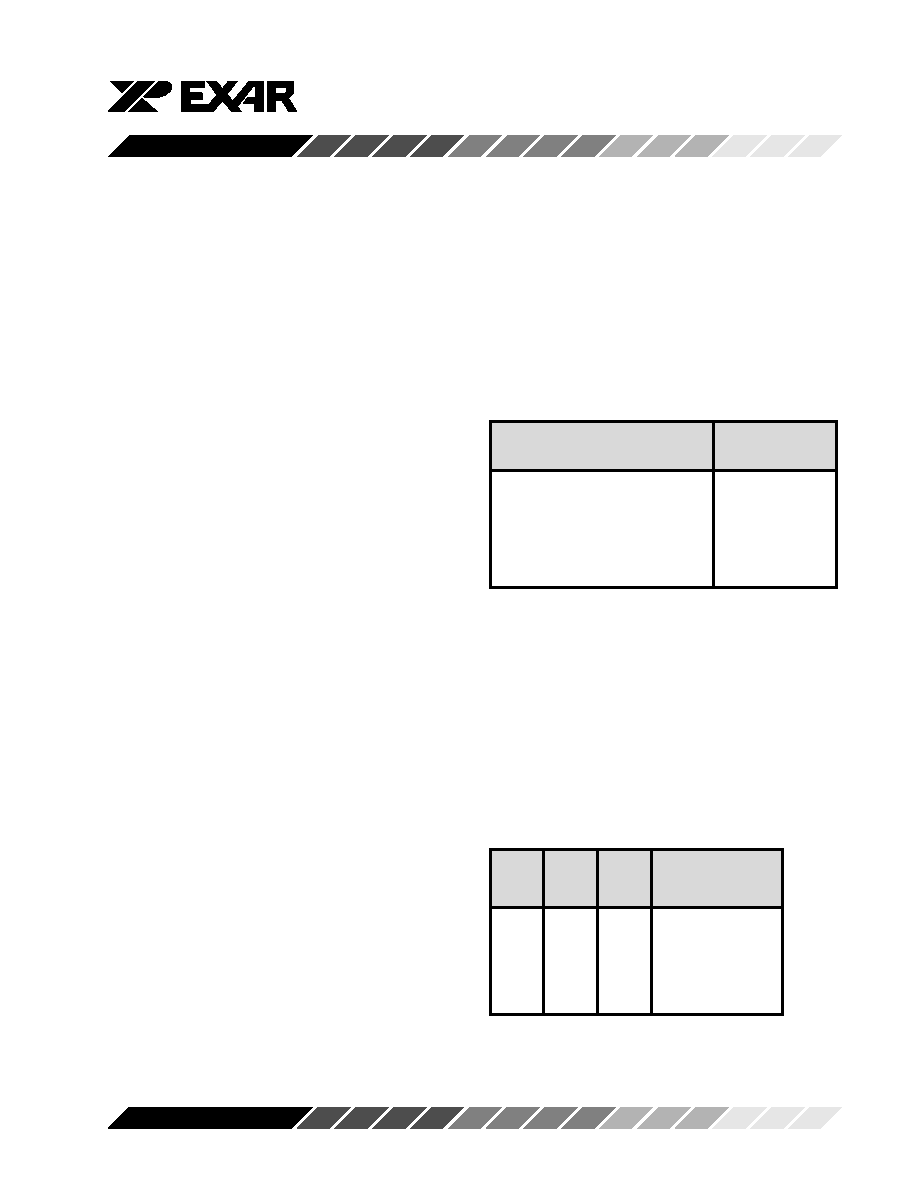- 您現(xiàn)在的位置:買賣IC網(wǎng) > PDF目錄3761 > ST16C454CJ68TR-F (Exar Corporation)IC UART QUAD 68PLCC PDF資料下載
參數(shù)資料
| 型號: | ST16C454CJ68TR-F |
| 廠商: | Exar Corporation |
| 文件頁數(shù): | 29/29頁 |
| 文件大?。?/td> | 0K |
| 描述: | IC UART QUAD 68PLCC |
| 標準包裝: | 250 |
| 特點: | * |
| 通道數(shù): | 4,QUART |
| FIFO's: | 1 字節(jié) |
| 電源電壓: | 2.97 V ~ 5.5 V |
| 帶故障啟動位檢測功能: | 是 |
| 帶調(diào)制解調(diào)器控制功能: | 是 |
| 帶CMOS: | 是 |
| 安裝類型: | 表面貼裝 |
| 封裝/外殼: | 68-LCC(J 形引線) |
| 供應(yīng)商設(shè)備封裝: | 68-PLCC |
| 包裝: | 帶卷 (TR) |
第1頁第2頁第3頁第4頁第5頁第6頁第7頁第8頁第9頁第10頁第11頁第12頁第13頁第14頁第15頁第16頁第17頁第18頁第19頁第20頁第21頁第22頁第23頁第24頁第25頁第26頁第27頁第28頁當前第29頁

ST16C454
9
Rev. 3.31
GENERAL DESCRIPTION
The 454 provides serial asynchronous receive data
synchronization, parallel-to-serial and serial-to-parallel
data conversions for both the transmitter and receiver
sections. These functions are necessary for converting
the serial data stream into parallel data that is required
with digital data systems. Synchronization for the serial
data stream is accomplished by adding start and stops
bits to the transmit data to form a data character
(character orientated protocol). Data integrity is insured
by attaching a parity bit to the data character. The parity
bit is checked by the receiver for any transmission bit
errors. The electronic circuitry to provide all these
functions is fairly complex especially when manufac-
tured on a single integrated silicon chip. The ST16C454
represents such an integration with greatly enhanced
features. The 454 is fabricated with an advanced CMOS
process to achieve low drain power and high speed
requirements.
The 454 combines the package interface modes of the
ST16C454 and ST68C454 series on a single inte-
grated chip. The 16 mode interface is designed to
operate with the Intel type of microprocessor bus while
the 68 mode is intended to operate with Motorola, and
other popular microprocessors.
The 454 is capable of operation to 1.5Mbps with a 24
MHz crystal or external clock input. With a crystal of
14.7464 MHz, the user can select data rates up to
921.6Kbps.
The rich feature set of the 454 is available through
internal registers. Selectable TX and RX baud rates,
modem interface controls. In the 16 mode INTSEL
and MCR bit-3 can be configured to provide a software
controlled or continuous interrupt capability.
FUNCTIONAL DESCRIPTIONS
Interface Options
Two user interface modes are selectable for the 454
package. These interface modes are designated as
the “16 mode” and the “68 mode.” This nomenclature
corresponds to the early ST16C454 and ST68C454
package interfaces respectively.
The 16 Mode Interface
The 16 mode configures the package interface pins for
connection as a standard 16 series (Intel) device and
operates similar to the standard CPU interface avail-
able on the ST16C454. In the 16 mode (pin 16/-68 logic
1) each UART is selected with individual chip select (-
CSx) pins as shown in Table 2 below.
Table 2, SERIAL PORT CHANNEL SELECTION
GUIDE, 16 MODE INTERFACE
-CSA
-CSB
-CSC
-CSD
UART
CHANNEL
1
None
0111
A
1011
B
1101
C
1110
D
The 68 Mode Interface
The 68 mode configures the package interface pins for
connection with Motorola, and other popular micro-
processor bus types. The interface operates similar to
the ST68C454. In this mode the 454 decodes two
additional addresses, A3-A4 to select one of the four
UART ports. The A3-A4 address decode function is
used only when in the 68 mode (16/-68 logic 0), and is
shown in Table 3 below.
Table 3, SERIAL PORT CHANNEL SELECTION
GUIDE, 68 MODE INTERFACE
-CS
A4
A3
UART
CHANNEL
1
N/A
None
000
A
001
B
010
C
011
D
相關(guān)PDF資料 |
PDF描述 |
|---|---|
| XR16C850CMTR-F | IC UART FIFO 128B 48TQFP |
| XR16L570IL32-F | IC UART FIFO 16B 32QFN |
| XR16L651CM-F | IC UART FIFO 32B 48TQFP |
| XR68C92IJTR-F | DUAL CHANNEL UART 44PLCC |
| XR68C192CVTR-F | IC UART FIFI DUAL 44LQFP |
相關(guān)代理商/技術(shù)參數(shù) |
參數(shù)描述 |
|---|---|
| ST16C454IJ68 | 制造商:EXAR 制造商全稱:EXAR 功能描述:QUAD UNIVERSAL ASYNCHRONOUS RECEIVER/TRANSMITTER (UART) |
| ST16C454IJ68-F | 功能描述:UART 接口集成電路 QUAD UART RoHS:否 制造商:Texas Instruments 通道數(shù)量:2 數(shù)據(jù)速率:3 Mbps 電源電壓-最大:3.6 V 電源電壓-最小:2.7 V 電源電流:20 mA 最大工作溫度:+ 85 C 最小工作溫度:- 40 C 封裝 / 箱體:LQFP-48 封裝:Reel |
| ST16C454IJ68TR-F | 功能描述:UART 接口集成電路 QUAD UART RoHS:否 制造商:Texas Instruments 通道數(shù)量:2 數(shù)據(jù)速率:3 Mbps 電源電壓-最大:3.6 V 電源電壓-最小:2.7 V 電源電流:20 mA 最大工作溫度:+ 85 C 最小工作溫度:- 40 C 封裝 / 箱體:LQFP-48 封裝:Reel |
| ST16C550 | 制造商:EXAR 制造商全稱:EXAR 功能描述:UART WITH 16-BYTE FIFO’s |
| ST16C550_05 | 制造商:EXAR 制造商全稱:EXAR 功能描述:UART WITH 16-BYTE FIFO’s |
發(fā)布緊急采購,3分鐘左右您將得到回復(fù)。